Gear Up Your Bar Game – A Complete Bar Equipment Guide

Why Every Great Bar Starts with the Right Equipment
A comprehensive bar equipment guide is your roadmap to building a professional-quality bar that delivers exceptional drinks and memorable experiences. Whether you're opening a commercial establishment or elevating your home bar setup, having the right tools makes all the difference between amateur hour and mixology mastery.
Essential Bar Equipment Categories:
- Mixing Tools: Shakers, strainers, jiggers, bar spoons, muddlers
- Glassware: Rocks, highball, coupe, martini, wine, and specialty glasses
- Storage & Cooling: Refrigeration units, ice makers, speed rails, glass racks
- Service Items: Pourers, cutting boards, bar mats, towels, garnish containers
- Technology: POS systems, inventory management software
The cocktail renaissance has transformed drinking culture. Today's customers expect craft-quality beverages served with precision and flair. As one industry expert notes: "Behind the bar, you need a lot of bar tools and equipment, often more than you think, especially if you want to be perceived as a professional."
Your equipment choices directly impact three critical areas: drink quality, service speed, and operational efficiency. The right bar setup reduces inventory counting time by up to 85% while ensuring consistent, professional results every time.
From Boston shakers to POS systems, every piece serves a purpose in creating smooth operations and satisfied customers. The key is understanding which tools are truly essential versus nice-to-have additions.
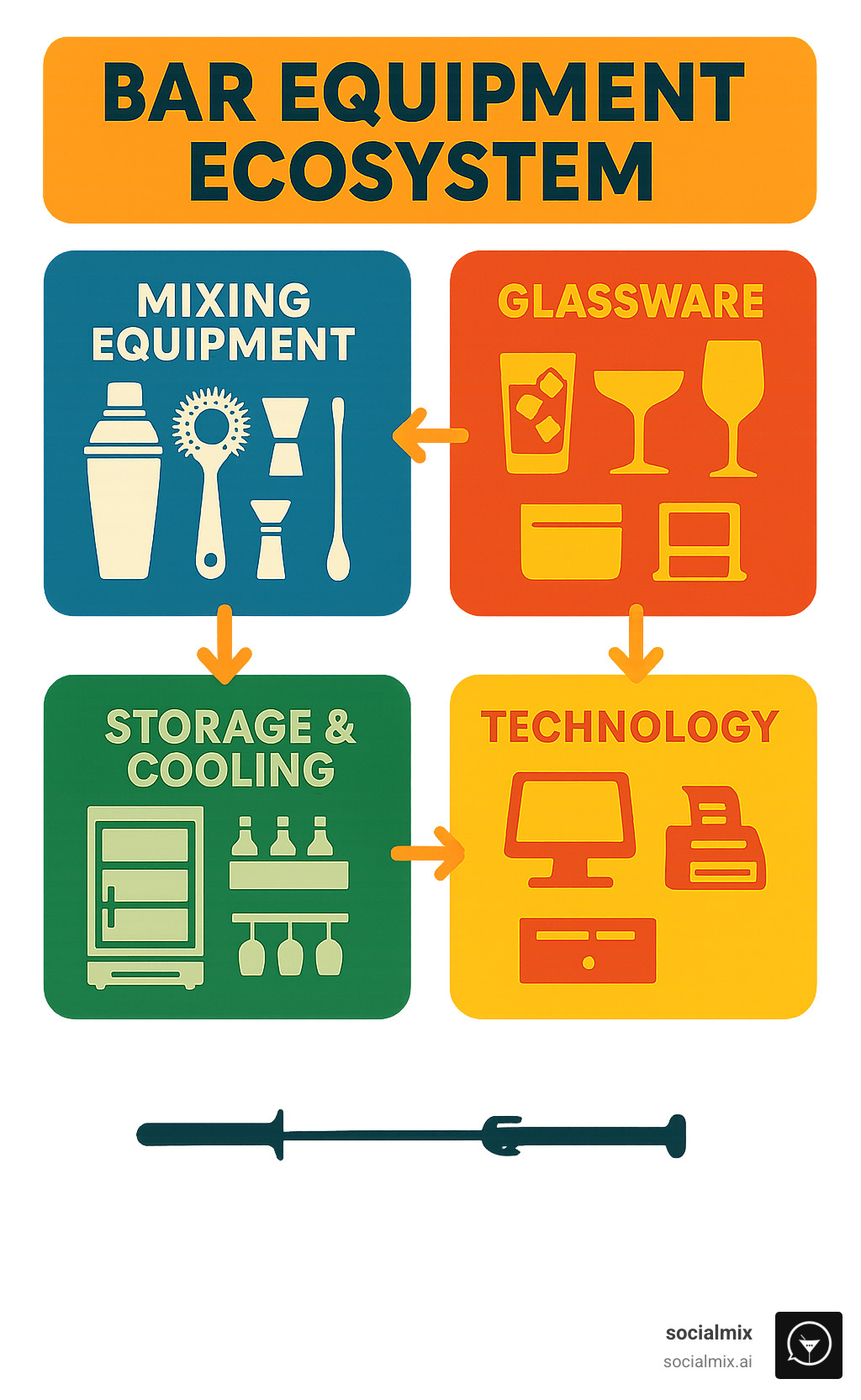
Bar Equipment Guide: Essential Tools Every Bar Needs
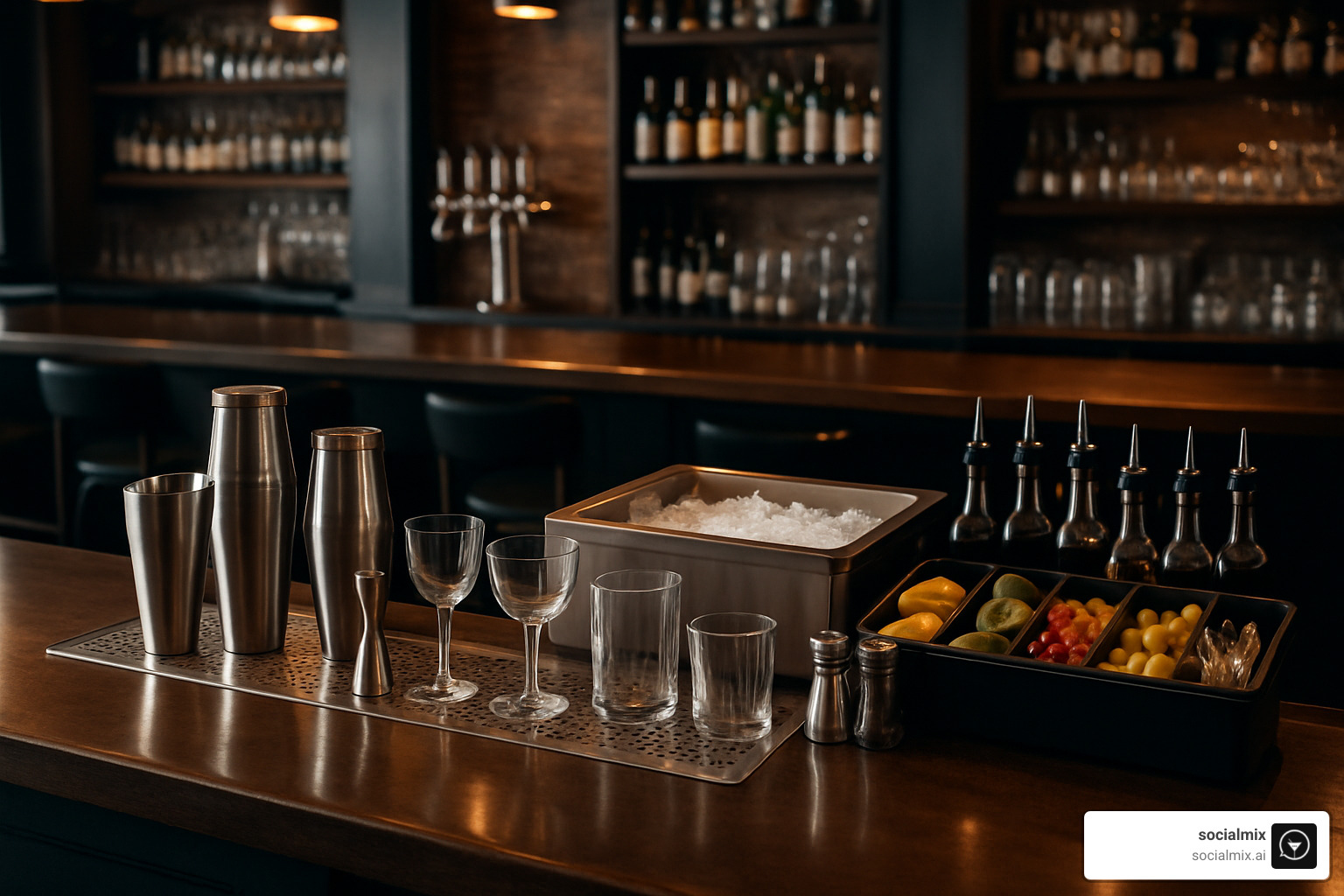
Walking into a well-equipped bar feels like stepping into a mixologist's playground. Every tool has its place, every piece serves a purpose, and together they create the magic that transforms simple ingredients into memorable experiences. This bar equipment guide will walk you through the 22 essential items that separate professional bars from amateur setups.
Think of your bar equipment as the foundation of great hospitality. Without the right tools, even the most skilled bartender struggles to deliver consistent, quality drinks. But with a properly equipped station, you're ready to handle everything from a simple whiskey neat to an elaborate craft cocktail with multiple components.
The beauty of bar equipment lies in how each piece works together. Your jiggers ensure precise measurements, while your shakers blend ingredients to perfection. Strainers catch unwanted ice and pulp, and bar spoons provide the gentle touch needed for stirred cocktails. Muddlers release essential oils from herbs, while cutting boards give you space for fresh garnish prep.
Behind every smooth bar operation, you'll find speed rails keeping well liquors within arm's reach and ice tools ensuring every drink stays perfectly chilled. Pour spouts control flow and prevent waste, while bar mats protect surfaces and provide grip during busy rushes.
The numbers tell an impressive story about our industry's resilience. Between 2006 and 2022, annual alcoholic beverage sales in the U.S. never dropped below 175 million, proving that well-equipped bars continue to thrive. This consistent demand means investing in quality equipment isn't just about immediate service—it's about building a foundation for long-term success.
Storage and organization tools like glass racks keep your workspace efficient, while essential utilities such as bottle openers, corkscrews, and citrus juicers handle the daily tasks that keep service flowing smoothly. Even simple items like garnish containers and tongs play crucial roles in maintaining hygiene and presentation standards.
More info about Essential Bartender Tools
Mixing & Shaking Core Kit – a mini bar equipment guide
Every great cocktail starts with proper mixing, and your choice of shakers and strainers can make or break your bar's efficiency. Professional bartenders have strong opinions about their tools, and for good reason—the right equipment makes the difference between struggling through a busy night and flowing through orders with confidence.
The Boston shaker reigns supreme in professional settings. This two-piece design uses either tin-and-tin or glass-and-tin combinations, and experienced bartenders love it for its speed and reliability. You can shake, strain, and move to the next drink without fumbling with multiple parts.
For those new to bartending, the cobbler shaker offers a gentler learning curve. Its three-piece design includes a built-in strainer, making it nearly foolproof for beginners. However, it's slower during high-volume service, which is why most professional bars eventually graduate to Boston shakers.
The French shaker represents a middle ground—a tin-and-tin design that offers superior thermal control for temperature-sensitive cocktails. It's less common but beloved by bartenders who prioritize precision over speed.
Your straining system works hand-in-hand with your shakers. The Hawthorne strainer with its distinctive spring coil fits perfectly in shaker tins and handles most shaken cocktails beautifully. For crystal-clear drinks, a fine strainer removes even the smallest ice shards and fruit particles. Traditional julep strainers work best with stirred drinks served from mixing glasses.
When choosing materials, stainless steel dominates professional kitchens for good reason—it's durable, hygienic, and provides excellent thermal properties. Weighted tins offer better balance and a more professional feel, while glass bottoms add visual appeal but require careful handling. Copper shakers make a statement, especially for specialty drinks like Moscow Mules.
As one industry veteran puts it: "Two-piece shakers are far superior to three-piece cobbler shakers" for commercial operations. The speed and reliability during busy periods simply can't be matched.
Measuring & Pouring Precision – another bar equipment guide focus
Consistency isn't just about pride—it's about profitability. Every over-poured drink cuts into your margins, while under-poured cocktails leave customers disappointed. The right measuring and pouring tools ensure every drink meets your standards while keeping costs under control.
Jiggers form the backbone of precise bartending. Standard sizes include 1 oz and 2 oz measurements, with many featuring 0.5 oz, 0.75 oz, and 1.5 oz variations. Japanese-style jiggers take precision further with interior measurement lines for half-measures. Want to test accuracy? Weigh water on sensitive scales—1 ml should equal 1 g.
Your pouring strategy depends on your bar's style and volume. Measured pourers control portion sizes automatically, making them perfect for high-volume operations or bars with less experienced staff. They directly impact profitability by eliminating overpouring—a common issue that quietly drains profits.
Free-flow spouts enable impressive bartending showmanship and faster service, but they require skilled bartenders who can count accurately while managing multiple orders. Speed pour spouts attempt to bridge this gap, offering reasonable control while maintaining service speed.
| Pour Method | Accuracy | Speed | Cost Control | Skill Required |
|---|---|---|---|---|
| Free Pour | Variable | Fast | Low | High |
| Jigger Measure | High | Medium | High | Medium |
| Measured Pourer | High | Fast | High | Low |
The impact on your bottom line can't be overstated. Using measured pourers allows you to control and manage your liquor inventory effectively, helping bartenders avoid overpouring and reducing operating costs. In high-volume operations, this simple tool can transform your profitability while maintaining drink quality.
Glassware & Presentation Mastery
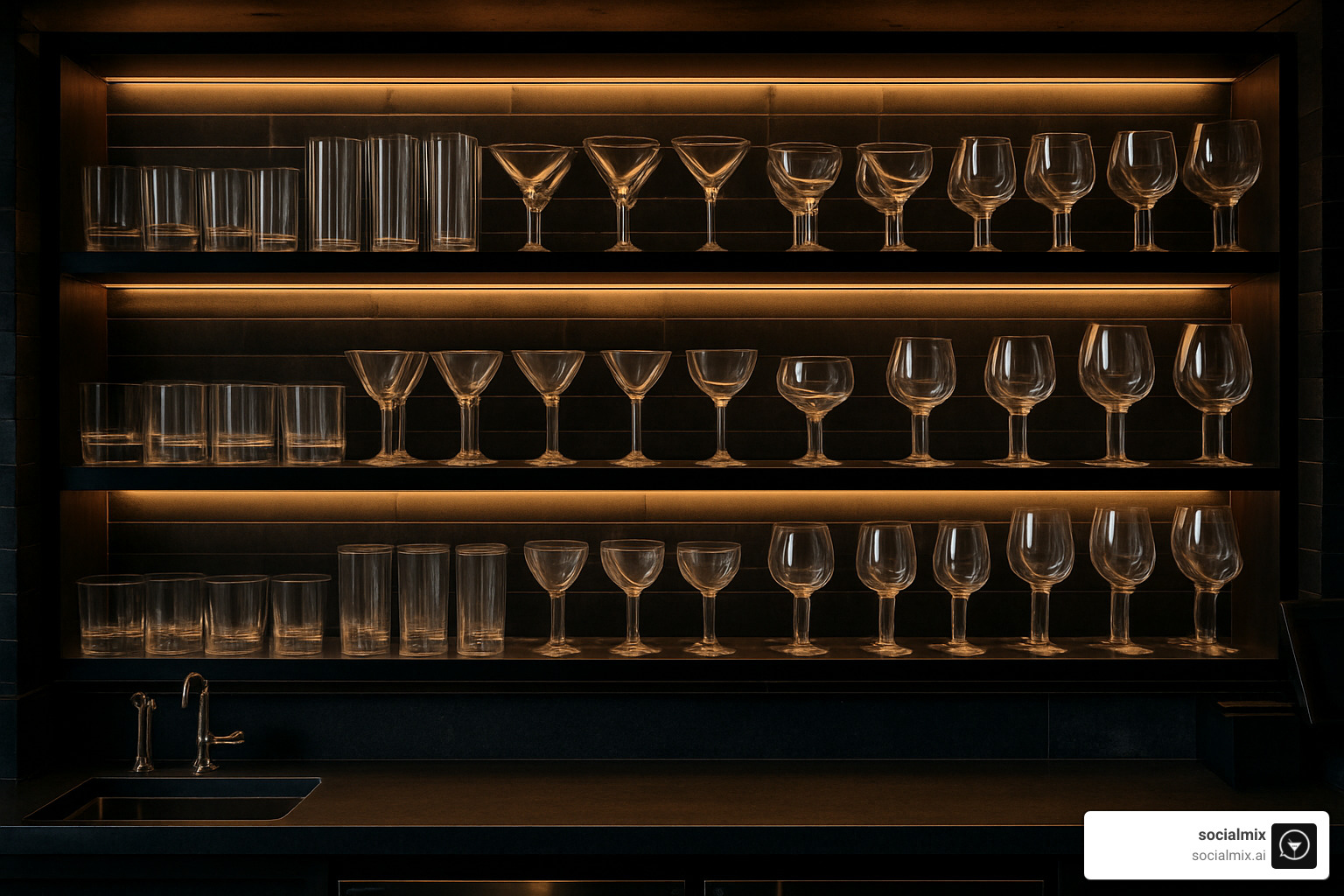
Your glassware collection is where cocktail craftsmanship meets visual storytelling. The right glass doesn't just hold your drink—it improves every sip by controlling aroma, maintaining temperature, and creating that perfect first impression. A well-stocked bar equipment guide wouldn't be complete without understanding how glassware transforms the entire drinking experience.
Most professional bars stock between 20-30 different glass styles, but you can start strong with the essentials. Rocks glasses in 8-12 oz sizes handle your whiskey neat and old-fashioned cocktails beautifully. Highball and Collins glasses at 10-14 oz capacity are workhorses for mixed drinks with ice and mixers.
The neat coupe glass has made a serious comeback, offering 5-7 oz capacity for stirred cocktails without ice. Many bartenders now prefer coupes over traditional martini glasses because they're more stable and easier to handle during busy service. Wine glasses for red, white, and champagne service remain essential, while shot glasses at 1-2 oz handle neat spirits and layered shots.
Don't overlook specialty options like metal beverageware. Copper mugs for Moscow Mules aren't just Instagram-worthy—they actually improve the drinking experience through temperature conductivity. Reusable plastic glassware becomes essential for poolside service, outdoor events, or any high-breakage environment.
Here's where presentation becomes an art form. Custom coasters, branded napkins, and personalized cocktail picks transform ordinary service into memorable experiences. At socialmix, we understand that these thoughtful details create the social connections that turn casual drinks into lasting memories.
The Ultimate List of Essential Bar Tools and Equipment
Matching Glass to Drink Style
The science behind glass selection is fascinating once you understand how shape affects your senses. Different glass geometries actually control how aromas reach your nose, how temperature transfers from your hand, and even how you perceive portion sizes.
Aroma control works through simple physics. Narrow openings like those on wine glasses and snifters concentrate volatile compounds, intensifying the nose of your drink. Wide openings on coupes and rocks glasses let aromatics disperse more gently, creating a balanced sensory experience. Flared rims cleverly direct those aromatics straight toward your nose.
Temperature management becomes crucial for drink quality. Stemmed glasses prevent your hand warmth from affecting chilled cocktails—there's nothing worse than a warm martini. Thick-walled glasses provide natural insulation for temperature-sensitive drinks, while starting with chilled glassware helps maintain optimal serving temperature throughout the drinking experience.
The visual impact matters too. A properly proportioned glass makes even a simple drink look professionally crafted, while the wrong choice can make expensive spirits appear cheap.
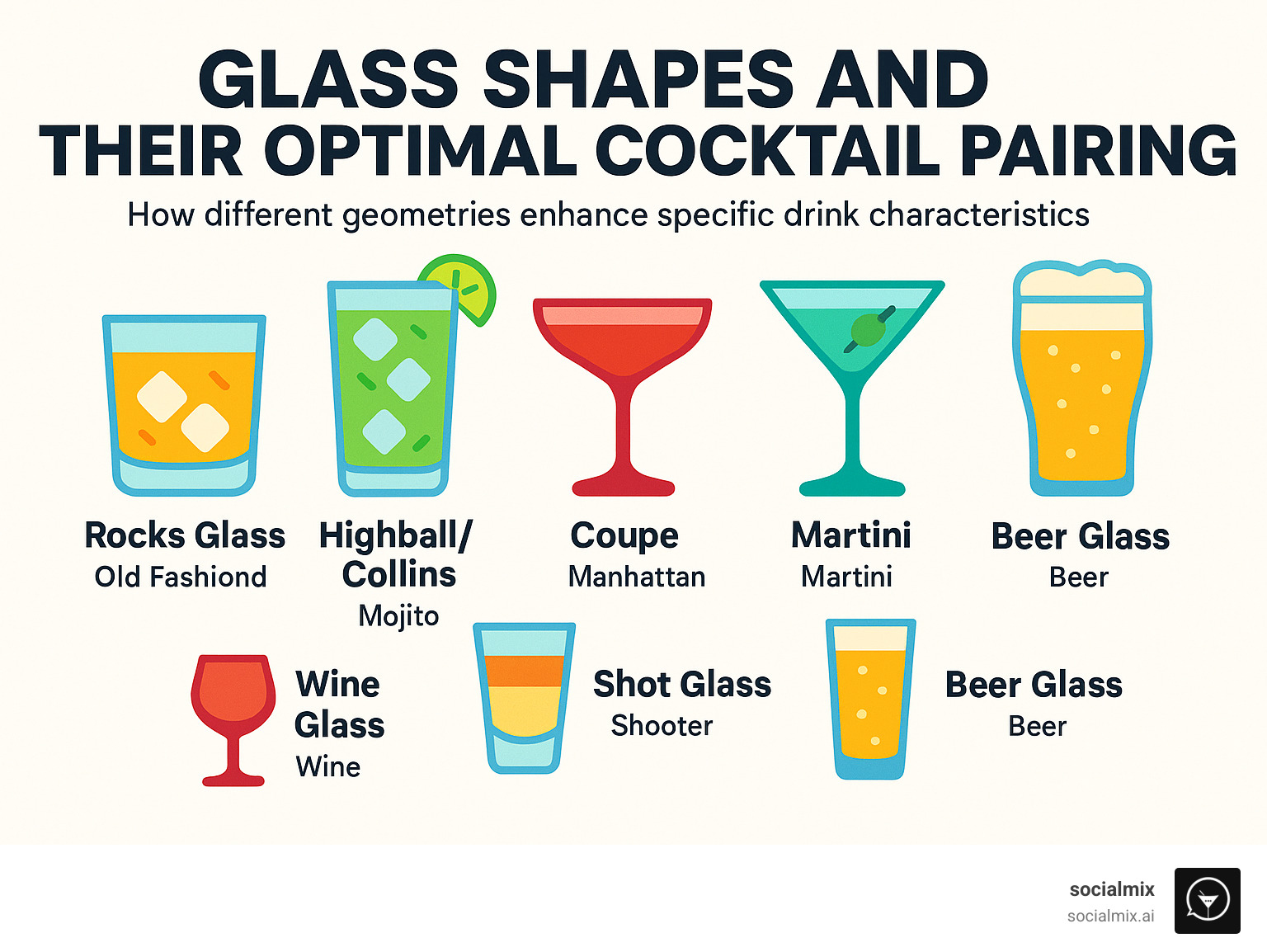
Custom & Branded Accessories
The magic happens in the details that most people notice subconsciously. Professional presentation extends far beyond glassware to every single touchpoint of the drinking experience. These finishing touches create brand recognition while actually improving service efficiency.
Coasters offer the perfect branding opportunity—whether you choose tile, leather, or wood options with custom designs. They protect surfaces while keeping your brand visible throughout the entire drinking experience. Cocktail napkins with embroidered or printed logos add a touch of class that guests often take home as souvenirs.
Garnish picks might seem minor, but branded or themed selections show attention to detail that separates professional service from amateur hour. Glass markers like personalized wine charms help guests keep track of their drinks while adding visual interest.
Research consistently shows that custom coasters serve double duty as both surface protection and powerful advertising tools. They create lasting impressions that extend well beyond the immediate drinking experience. Learn more about coaster branding benefits to understand how these seemingly small details contribute to your overall brand strategy and customer loyalty.
These accessories aren't just pretty additions—they're functional tools that improve the social experience and create those memorable moments that keep people coming back.
Refrigeration, Storage & Technology
Behind every smooth-running bar lies a foundation of reliable cooling systems, smart storage solutions, and integrated technology that most customers never see. These essential elements work together to keep your operation running efficiently, your ingredients fresh, and your service seamless.
Keeping Everything Cool
Your refrigeration setup forms the backbone of quality control. Back bar coolers with glass doors serve double duty – they keep your most-used spirits at the perfect temperature while creating an attractive display that customers can see. These under-counter units make inventory checks a breeze and help bartenders quickly spot when stock is running low.
Kegerators are non-negotiable if you're serving draft beer. They maintain that crucial 38-40°F temperature range that keeps beer tasting fresh and prevents waste from over-foaming. Nothing kills the mood like warm, flat beer or a bartender struggling with a poorly maintained tap system.
Don't overlook dedicated wine coolers if you're serious about wine service. Different wine styles need different storage temperatures, and a quality wine cooler with separate zones shows customers you care about serving their wine properly.
Your ice maker might seem basic, but it's actually one of your most important pieces of equipment. Commercial units that produce 25mm cubes give you optimal dilution control – the difference between a perfectly balanced cocktail and a watery disappointment.
Smart Storage Solutions
Efficient storage transforms good bartenders into great ones. Speed rails keep your well liquors within arm's reach, eliminating the dance of reaching across the bar for every drink. Position them strategically based on your most popular cocktails.
Glass racks do more than just store glassware – they become part of your bar's visual appeal. Overhead racks create an impressive display while freeing up valuable counter space. Under-bar racks keep backup glassware organized and easily accessible during busy rushes.
Garnish stations with built-in refrigeration keep your perishable ingredients fresh throughout service. Nothing looks less professional than wilted mint or brown lemon wedges, and a proper garnish station prevents these embarrassing moments.
Technology That Actually Helps
Modern POS systems have completely changed how bars operate, and honestly, it's about time. A good POS system helps bar owners manage customer tabs and transactions more efficiently, cutting down on those frustrating manual errors that cost money and slow down service.
Cloud-based systems are game-changers for multi-location operators or owners who want to monitor their business remotely. Real-time sales tracking means you can spot trends immediately and make adjustments on the fly.
Here's a stat that'll grab your attention: advanced inventory management systems like BinWise can reduce inventory counting time by up to 85%. That tedious weekly task that everyone dreads? It becomes an efficient, mostly automated process that frees up your time for more important things.
Latest research on mobile POS efficiency
Smart Tech for Smooth Service
The right technology integration separates modern bars from those still stuck in the past. But remember – technology should make your life easier, not more complicated.
Essential Features That Matter
Inventory tracking with automated pour counting gives you real-time stock levels without the guesswork. You'll know exactly when to reorder and can catch shrinkage issues before they become serious problems.
Sales analytics break down performance by bartender, time period, and menu item. This data helps you identify your most profitable drinks, spot training opportunities, and optimize your menu based on what actually sells.
Customer management features let you build loyalty programs and track customer preferences. When a regular walks in and you can immediately pull up their favorite drink, that personal touch creates lasting impressions.
Remote access capabilities mean you can monitor operations from anywhere with internet connectivity. Whether you're at home or on vacation, you can keep tabs on sales, inventory, and staff performance.
The reality of bar operations is high staff turnover, which makes intuitive POS interfaces absolutely critical. New employees need to get up to speed quickly, and complicated systems slow down service during those crucial learning periods.
More info about using and maintaining tools
Buying Smart: Selecting, Budgeting & Sourcing Equipment
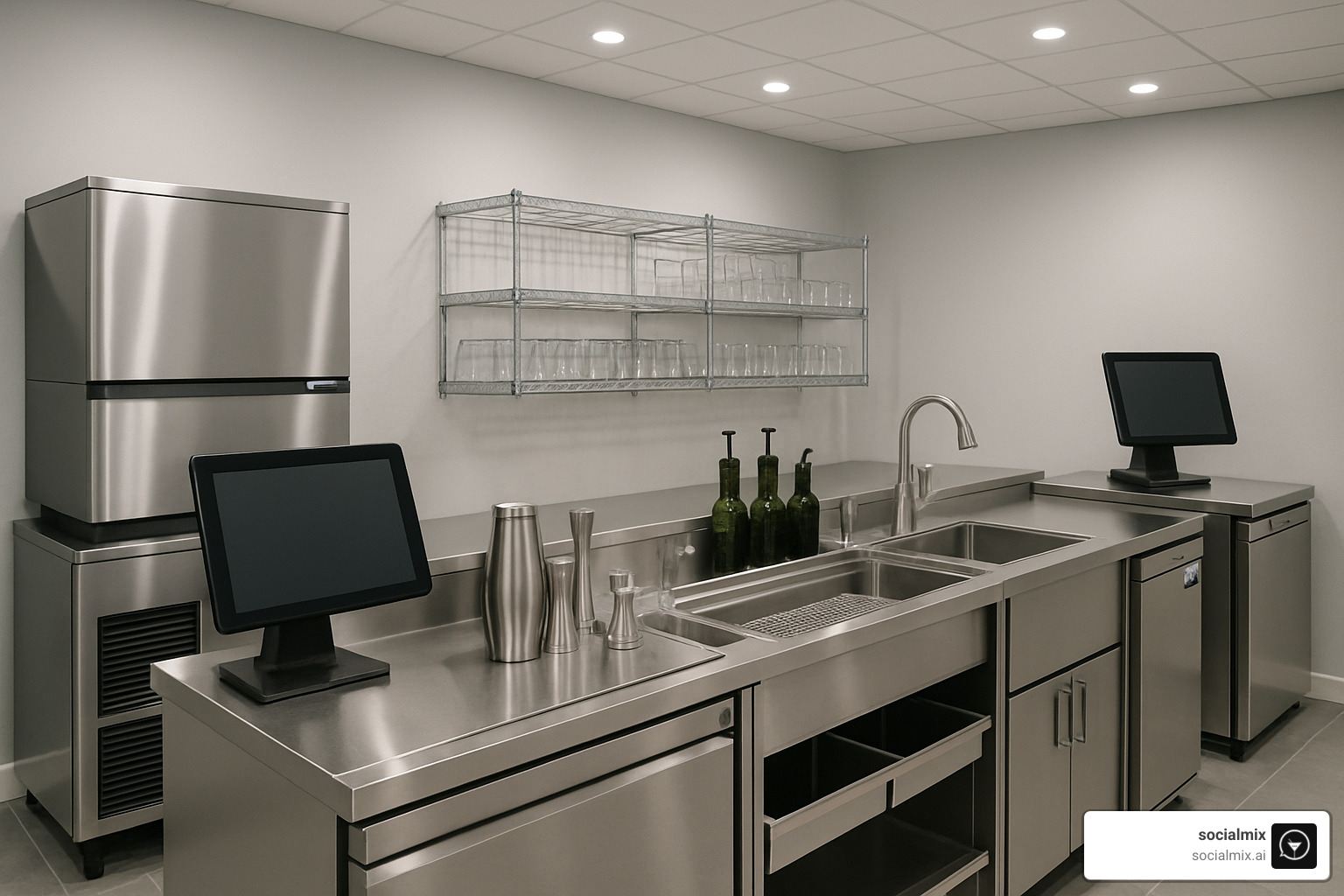
Making smart equipment choices can make or break your bar's success. The difference between a thriving establishment and one struggling with constant repairs often comes down to those initial purchasing decisions. Your bar equipment guide strategy should balance upfront costs with long-term reliability.
New equipment gives you peace of mind with full warranties and the latest features. You'll pay more initially, but you're investing in reliability and performance. Used equipment can save significant money upfront, especially for items like glassware and basic tools that don't see heavy mechanical stress.
Leasing programs offer an interesting middle ground. With 98% of businesses qualifying and 24-hour pre-approval available, leasing lets you spread costs while preserving cash flow. This works particularly well for expensive items like ice machines and POS systems.
Many successful bar owners use a hybrid approach. They buy new for critical items like refrigeration units and shakers that get constant use, while purchasing used items for things like cutting boards and backup glassware.
Budget planning becomes much easier when you follow the industry standard of targeting 50% of revenue for combined food, labor, and equipment costs. Set aside 3-5% of your equipment value annually for maintenance, and plan for technology upgrades every 3-5 years.
Commercial-grade equipment costs more for good reason. It's built to handle the constant use that would quickly destroy residential-grade alternatives.
Evaluating Quality & ROI
The materials your equipment is made from tell the whole story about how long it will last and how much maintenance you'll need.
Stainless steel dominates professional bars because it resists corrosion, stays hygienic, and looks professional even after years of use. You'll pay more upfront, but stainless steel shakers, jiggers, and bar spoons can last decades with proper care.
Plastic components cost less initially but often end up being expensive in the long run. They stain easily, absorb odors, and crack under the stress of busy service. Save plastic for items like garnish containers where replacement is easy and inexpensive.
The difference between commercial grade and residential grade equipment becomes obvious quickly. Commercial equipment handles continuous use without breaking down. That home-style blender might seem like a bargain until it burns out during your first busy weekend.
Energy efficiency matters more than many bar owners realize. Energy Star-rated refrigeration equipment costs more initially but saves money every month on utility bills. Better insulation keeps compressors from working overtime, extending equipment life significantly.
Regular maintenance keeps efficient equipment running efficiently. Neglect maintenance on even the best equipment, and you'll watch your energy costs climb while performance drops.
Sourcing Options & Negotiation Tips
Finding the right suppliers makes equipment purchasing much easier and often much cheaper. Each type of supplier offers different advantages depending on what you need.
Restaurant supply stores provide the personal touch that online retailers can't match. You can see equipment in person, get immediate answers to questions, and often receive same-day delivery for urgent needs. Building relationships with local suppliers pays off when you need emergency replacements or expert advice.
Online retailers offer competitive pricing and vast selection, but you sacrifice the personal service. This works well for standard items like jiggers and bar spoons where specifications are clear and quality is consistent across brands.
Bulk warehouse clubs provide excellent pricing on basic items like glassware and cleaning supplies. The selection is limited, but the savings can be substantial for high-volume purchases.
Direct manufacturer purchases offer the best pricing for large orders and allow custom specifications. This approach works best when outfitting an entire bar or chain of establishments.
Smart negotiation starts with package deals. Suppliers often provide better pricing when you bundle multiple items together. Ask about extended payment terms to improve cash flow, especially for large purchases.
Include service agreements in your negotiations. Getting maintenance and staff training included in the purchase price saves money and ensures proper equipment care from day one.
Many suppliers offer trade-in programs that offset new equipment costs with credits for old equipment. Even non-functional equipment often has scrap value that reduces your final bill.
Planning prevents poor purchasing decisions. Download our free bar equipment checklist template to organize your needs and ensure you don't overlook critical items or overspend on unnecessary ones.
Organizing, Cleaning & Maintaining Your Bar Arsenal
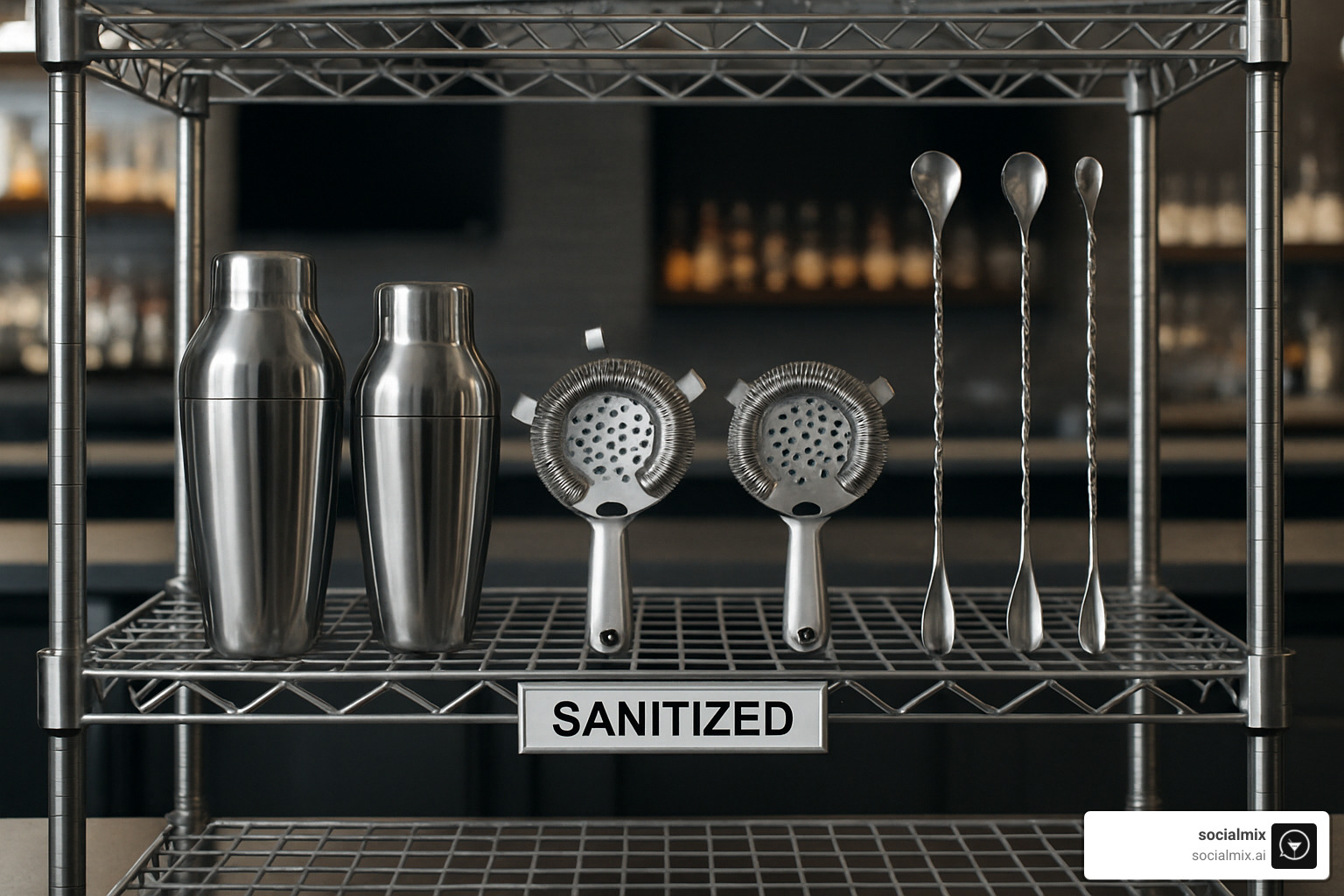
Think of your bar equipment guide as more than just a shopping list – it's your roadmap to creating a workspace that stays clean, organized, and running smoothly. Just like a chef's kitchen, your bar needs systems that work even during the busiest Friday night rush.
The foundation of any professional bar starts with proper cleaning protocols. The three-compartment sink method isn't just restaurant code compliance – it's your secret weapon against cross-contamination and equipment damage. First compartment for washing with hot soapy water, second for rinsing with clean water, and third for sanitizing with a 200 ppm chlorine solution. Let everything air dry completely to prevent recontamination.
Your shakers deserve special attention since they're the workhorses of cocktail service. Hand washing protects those beautiful finishes that dishwashers can damage over time. For cutting boards, a quick salt scrub followed by food-safe oil keeps wood boards in prime condition. Don't forget your ice machine – it needs daily cleaning and weekly deep sanitization to prevent that funky taste nobody wants in their premium cocktails.
Creating daily checklists might feel tedious at first, but they become lifesavers when training new staff or maintaining consistency across different shifts. Every bartender knows exactly what needs attention before, during, and after service.
Layout & Workflow Hacks
Smart bar organization turns chaos into choreography. The best bartenders move like dancers behind the bar, and that fluidity comes from thoughtful equipment placement, not just years of experience.
Mise en place – that French culinary term meaning "everything in its place" – becomes your mantra. Position your most-used tools within arm's reach of your primary mixing station. Speed rails should hold well liquors at the perfect height and angle for quick pours without awkward reaching.
Think vertically when space gets tight. Overhead glass racks serve double duty as storage and visual display, while keeping stemware safely away from the action zone. Your garnish station becomes command central when it's properly refrigerated and positioned where multiple bartenders can access it without bumping into each other.
The magic happens when you design flow patterns that minimize crossing paths. Nothing kills service speed like bartenders doing an awkward dance around each other while trying to reach essential tools. Smart placement of tool caddies gives you mobile organization that adapts to different service styles.
Longevity Through Proper Care
Here's the truth about bar equipment – a little preventative care saves you thousands in replacement costs and prevents those nightmare moments when your ice machine dies during a heat wave.
Daily maintenance feels like extra work until you realize it takes five minutes and prevents hours of deep cleaning later. Visual inspections catch small problems before they become expensive disasters. Weekly deep cleans keep everything running at peak performance while monthly detailed inspections ensure nothing gets overlooked.
Descaling your ice machines and dishwashers removes mineral buildup that slowly chokes performance. Most operators wait until equipment fails, then wonder why their utility bills skyrocketed. Sharp knives aren't just safer – they make garnish prep faster and more precise. Gasket replacement on refrigeration units prevents air leaks that force compressors to work overtime.
Professional service calls might seem expensive, but quarterly system optimization often pays for itself through improved efficiency and extended equipment life. Smart bar owners track these maintenance costs as investments, not expenses.
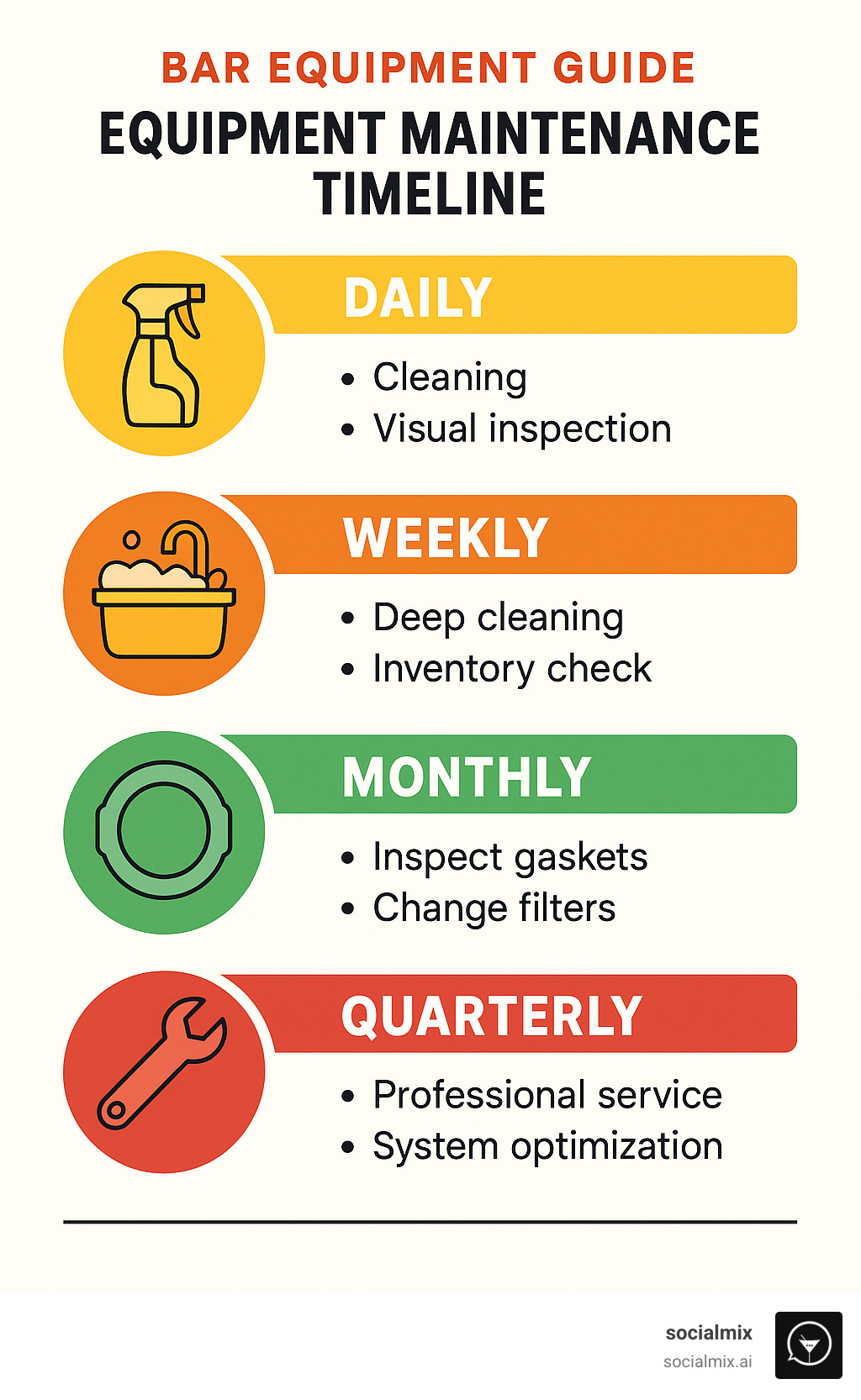
Frequently Asked Questions about Bar Equipment
Starting a new bar or upgrading your current setup? You're not alone in wondering about the essentials. These are the questions we hear most often from bar owners, and honestly, they're the same ones we asked when we first started exploring professional bartending.
What essential equipment does every start-up bar need?
Building your first bar can feel overwhelming, but breaking it down into must-haves makes the process much more manageable. Think of it as creating your bar equipment guide foundation – everything else builds from here.
Your immediate necessities start with the mixing essentials. You'll need cocktail shakers in both Boston and cobbler styles, since different bartenders prefer different tools. Add jiggers in 1 oz and 2 oz sizes for consistent measurements, plus Hawthorne and fine strainers to keep your cocktails smooth and professional-looking.
Don't forget the supporting players that make everything work smoothly. Bar spoons and muddlers handle stirring and ingredient preparation, while a solid glassware collection covering rocks, highball, wine, and shot glasses serves most drink requests. Your ice machine and storage bins keep everything properly chilled, and speed rails with pour spouts make service faster during busy periods.
The behind-the-scenes infrastructure matters just as much. Refrigeration units like back bar coolers and kegerators maintain proper temperatures, while a glass washer or three-compartment sink keeps everything sanitary. A reliable POS system handles transactions smoothly, and basic cleaning supplies and sanitizers maintain health department standards.
Budget-wise, plan for $15,000-$25,000 for essential equipment in a small to medium bar. Yes, it's a significant investment, but remember this foundation supports every drink you'll serve and every customer experience you'll create.
How do I choose between commercial and basic bar gear?
This decision really comes down to understanding your bar's personality and needs. It's like choosing between a reliable workhorse and a weekend warrior – both have their place, but the right choice depends on your specific situation.
Commercial grade equipment shines when you're expecting high volume and consistent use. These pieces are built like tanks, designed for continuous operation without breaking down when you need them most. The superior materials and construction mean they'll still be working smoothly years down the road, and the longer warranty periods provide peace of mind during those crucial early months.
The energy efficiency of commercial equipment often pays for itself over time, especially with refrigeration units running 24/7. Plus, when it's time to upgrade or sell, higher resale value helps recover your investment.
Basic grade equipment makes perfect sense for certain situations. If you're running a small neighborhood bar with predictable, moderate volume, or if budget constraints are your primary concern, basic equipment can serve you well. The lower upfront investment frees up capital for other priorities like marketing or inventory.
Here's our practical approach: choose commercial grade for the workhorses – ice machines, refrigeration, POS systems, and core bartending tools like shakers and jiggers. These items directly impact drink quality and service speed. Go with basic grade for specialty items you'll use occasionally, decorative pieces, or backup equipment that won't see daily abuse.
How often should I service refrigeration units and ice makers?
Think of equipment maintenance like taking care of your car – regular check-ups prevent those expensive roadside breakdowns that always seem to happen at the worst possible time.
Ice machines need the most attention because they work so hard. Professional service every 6 months keeps them running efficiently, while daily cleaning by your staff prevents the buildup that leads to poor ice quality or complete failure. Trust us, there's nothing worse than losing ice service during a busy weekend.
Refrigeration units generally need annual professional service with monthly filter changes that your team can handle. Kegerators require more frequent attention – line cleaning every 2 weeks maintains beer quality, while annual professional service keeps the cooling system running smoothly.
Your glass washer needs monthly descaling to prevent mineral buildup, plus professional service every 6 months to maintain sanitization effectiveness.
Watch for warning signs that mean you need immediate professional help. Unusual noises or vibrations often signal mechanical problems developing. Temperature fluctuations can spoil inventory and violate health codes. Excessive energy consumption might indicate failing components, while ice quality degradation or visible mold and mineral buildup require immediate attention.
The smartest move? Establish relationships with qualified service technicians before you need them. Emergency service calls during a busy Friday night cost three times more than scheduled maintenance visits. Plus, regular technicians learn your equipment's quirks and can spot potential problems before they become expensive disasters.
At socialmix, we understand that smooth operations create the memorable social experiences that keep customers coming back. Proper equipment maintenance isn't just about avoiding breakdowns – it's about consistently delivering the quality that builds your reputation and grows your business.
Conclusion
Building a successful bar operation starts with understanding that every piece of equipment serves a specific purpose in creating exceptional customer experiences. From the precision of a well-calibrated jigger to the reliability of a commercial-grade ice machine, each component contributes to the seamless delivery of quality drinks and memorable moments.
This comprehensive bar equipment guide represents more than just a shopping list—it's your roadmap to creating spaces where craftsmanship meets hospitality. Whether you're opening your first establishment or upgrading an existing setup, the foundation you build with quality equipment directly impacts every drink you serve and every customer interaction you create.
At socialmix, we understand that the right tools enable the artistry and passion that define great bartending. Our mission to bridge cocktail culture with sophisticated style extends beyond clothing and accessories to helping you create environments where every detail lifts the social experience. When you have the proper equipment foundation, you're free to focus on what matters most: crafting exceptional drinks and building connections with your guests.
Success in the bar industry comes from understanding how each piece fits into your unique operation. Start with the essentials—quality shakers, precise measuring tools, and reliable refrigeration. Invest in commercial-grade equipment where it matters most for your volume and service style. Build systematically toward your vision, adding specialized tools and technology as your operation grows and evolves.
Equipment is just the beginning of your journey. Proper maintenance extends the life of your investment while ensuring consistent performance. Staff training helps your team use tools effectively and safely. Attention to detail in organization and cleanliness separates outstanding bars from ordinary ones.
The hospitality industry thrives on memorable experiences, and those experiences start with having the right tools to execute your vision flawlessly. Whether you're perfecting classic cocktails or developing signature creations, quality equipment gives you the confidence to deliver consistency and excellence with every pour.
Your journey toward bar excellence starts with the right foundation. Choose wisely, maintain diligently, and let your passion for hospitality shine through every perfectly crafted drink. The investment you make in proper equipment today will pay dividends in customer satisfaction, operational efficiency, and long-term success.




Leave a comment